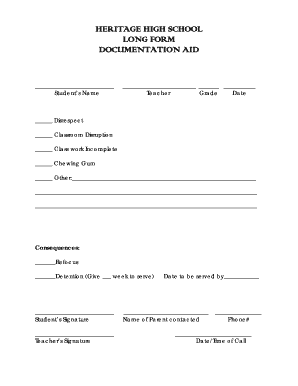
Get the free foreclosure form
Show details
Affidavit of Sale by Foreclosure State of County of (Name of Affine), of (address), Granter in the foregoing Deed, being duly sworn on oath, deposes and says: 1. The obligation secured by the Mortgage
We are not affiliated with any brand or entity on this form
Get, Create, Make and Sign

Edit your foreclosure form form online
Type text, complete fillable fields, insert images, highlight or blackout data for discretion, add comments, and more.

Add your legally-binding signature
Draw or type your signature, upload a signature image, or capture it with your digital camera.

Share your form instantly
Email, fax, or share your foreclosure form form via URL. You can also download, print, or export forms to your preferred cloud storage service.
Editing foreclosure online
To use our professional PDF editor, follow these steps:
1
Set up an account. If you are a new user, click Start Free Trial and establish a profile.
2
Prepare a file. Use the Add New button. Then upload your file to the system from your device, importing it from internal mail, the cloud, or by adding its URL.
3
Edit foreclosure statement form. Text may be added and replaced, new objects can be included, pages can be rearranged, watermarks and page numbers can be added, and so on. When you're done editing, click Done and then go to the Documents tab to combine, divide, lock, or unlock the file.
4
Get your file. When you find your file in the docs list, click on its name and choose how you want to save it. To get the PDF, you can save it, send an email with it, or move it to the cloud.
With pdfFiller, dealing with documents is always straightforward. Try it right now!
How to fill out foreclosure form

How to fill out foreclosure:
01
Gather all necessary documents such as loan agreements, mortgage documents, and any other relevant paperwork related to the foreclosure process.
02
Carefully review all documents and ensure that they are filled out accurately and completely.
03
Seek legal advice or consult with a foreclosure attorney to understand the specific requirements and processes involved in filling out the foreclosure paperwork.
04
Follow the instructions provided by the lender or the court when filling out the foreclosure forms.
05
Double-check all information entered on the forms, including personal details, loan information, and property details.
06
Make copies of all filled-out forms and keep them for your records.
07
Submit the completed foreclosure forms to the appropriate recipient, whether it is the lender, court, or any other designated party.
08
Follow up with the relevant parties to ensure that the foreclosure process is progressing accordingly.
Who needs foreclosure:
01
Individuals or families who are unable to make regular mortgage payments due to financial hardships or other reasons.
02
Lenders or financial institutions that need to enforce their right to reclaim a property that has been used as collateral for a loan.
03
Courts or legal authorities that oversee the foreclosure process and ensure the proper procedures are followed.
Fill sale foreclosure : Try Risk Free
People Also Ask about foreclosure
How do I write a foreclosure letter?
How to file for foreclosure Illinois?
How do you foreclose in Oklahoma?
How do you foreclose in Arizona?
What is the first step in the foreclosure process?
How long does it take to foreclose in Illinois?
For pdfFiller’s FAQs
Below is a list of the most common customer questions. If you can’t find an answer to your question, please don’t hesitate to reach out to us.
What information must be reported on foreclosure?
Foreclosure information that must be reported includes the name of the borrower, the address of the property, the original loan amount, the total amount due, the date of the sale, the trustee or auctioneer conducting the sale, and the name of the purchaser.
What is foreclosure?
Foreclosure is a legal process in which a lender, typically a bank or mortgage company, takes possession of a property from a borrower who has failed to make their mortgage payments as agreed. It is a result of defaulting on the mortgage loan, where the borrower is unable to continue paying the mortgage due to financial difficulties. In such cases, the lender or the mortgage holder has the right to sell the property to recover the outstanding loan balance. Foreclosure procedures can vary by country and state, but they generally involve several stages, including notification to the borrower, public auction, and eviction.
Who is required to file foreclosure?
The entity or individual that is required to file a foreclosure typically depends on the jurisdiction and the specific circumstances surrounding the case. In general, a lender or mortgage holder has the legal right to initiate foreclosure proceedings if the borrower defaults on their mortgage payments. The lender typically files the foreclosure action in court to enforce their right to repossess the property and sell it to recover the unpaid loan balance.
However, it's important to note that foreclosure laws can vary significantly by country, state, or region, and there may be specific requirements or procedures that must be followed. Therefore, it is advisable to consult with a legal professional or seek local legal advice in order to fully understand the specific foreclosure requirements applicable to a particular situation.
How to fill out foreclosure?
Filling out a foreclosure typically involves a legal process that varies depending on the jurisdiction and specific circumstances. However, here is a general outline of steps that may guide you in filling out a foreclosure:
1. Obtain foreclosure forms: Contact your local courthouse or attorney to obtain the necessary foreclosure forms. These may include a summons, complaint, lis pendens, and other relevant documents.
2. Review the forms: Familiarize yourself with the foreclosure forms and read the instructions carefully. Ensure you have all the required information, and determine if any additional supporting documents are needed.
3. Gather information: Collect all the relevant details about the property, the borrower, and the loan. This may include the property's address, legal description, loan amount, outstanding payments, and any applicable notices or communications.
4. Fill out the necessary forms: Complete the foreclosure forms accurately and thoroughly. Provide all required information in the appropriate fields, including your contact information, the borrower's information, and the reason for foreclosure.
5. Attach supporting documents: Include any supporting documents required by the foreclosure forms or your jurisdiction. This may include loan agreements, payment history, default notices, or any other relevant paperwork.
6. Sign and date the forms: Ensure that all necessary signatures and dates are included in the appropriate sections of the forms. This may involve signing as the lender, attorney, or representative of the lender.
7. Serve the foreclosure documents: Once completed, follow the legal process for serving the foreclosure documents to the borrower. This generally involves delivering the forms personally, through certified mail, or hiring a process server.
8. File the documents with the court: After the borrower has been served, file the foreclosure forms with the appropriate court. Pay any applicable filing fees and follow any additional court procedures or requirements specific to your jurisdiction.
Note: It is essential to consult with a foreclosure attorney or legal professional to ensure you comply with all local laws, regulations, and procedures. They can provide guidance specific to your situation and jurisdiction to help you navigate the foreclosure process correctly.
What is the purpose of foreclosure?
The purpose of foreclosure is primarily to recover outstanding debts or loans owed by a borrower who has defaulted on their mortgage payments. While it can vary depending on the jurisdiction, foreclosure allows lenders or mortgage holders to take legal action to repossess and sell the property used as collateral for the loan, in order to recover the amount owed. The proceeds from the sale are then used to pay off the outstanding debt. Foreclosure serves as a mechanism to protect the lender's rights and interests in the event of default by the borrower.
What is the penalty for the late filing of foreclosure?
The penalties for late filing of foreclosure can vary depending on the jurisdiction and specific circumstances. In many cases, the penalties can include fines, interest charges, and additional legal costs. In some instances, the lender may also be required to restart the foreclosure process from the beginning, resulting in further delays and expenses. It is advisable to consult with a legal professional familiar with foreclosure laws in your specific area to determine the penalties that may apply in your situation.
Where do I find foreclosure?
The pdfFiller premium subscription gives you access to a large library of fillable forms (over 25 million fillable templates) that you can download, fill out, print, and sign. In the library, you'll have no problem discovering state-specific foreclosure statement form and other forms. Find the template you want and tweak it with powerful editing tools.
How do I edit foreclosure search in Chrome?
Get and add pdfFiller Google Chrome Extension to your browser to edit, fill out and eSign your refinancing foreclosure, which you can open in the editor directly from a Google search page in just one click. Execute your fillable documents from any internet-connected device without leaving Chrome.
Can I create an electronic signature for the foreclosure buy in Chrome?
As a PDF editor and form builder, pdfFiller has a lot of features. It also has a powerful e-signature tool that you can add to your Chrome browser. With our extension, you can type, draw, or take a picture of your signature with your webcam to make your legally-binding eSignature. Choose how you want to sign your foreclosure order form and you'll be done in minutes.
Fill out your foreclosure form online with pdfFiller!
pdfFiller is an end-to-end solution for managing, creating, and editing documents and forms in the cloud. Save time and hassle by preparing your tax forms online.

Foreclosure Search is not the form you're looking for?Search for another form here.
Keywords relevant to foreclosure get form
Related to notice of trustee sale california
If you believe that this page should be taken down, please follow our DMCA take down process
here
.





















